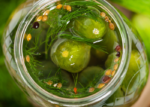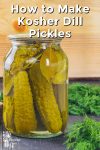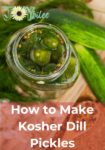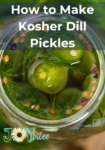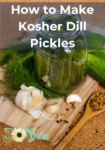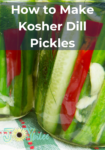Description
A simple and basic lacto-fermented dill pickle, like grandma used to make.
Ingredients
Scale
- Enough baby pickling cucumbers to fit in a 2-quart jar – about 1 ½ to 2 lbs.
- 15 to 20 peeled, whole garlic cloves
- 2 heads of fresh dill
- 2 tablespoons Himalayan salt or Celtic salt
- 2 tablespoons pickle juice from a successful batch of fermented vegetables or 2 tbsp. of whey (optional)
Instructions
- Clean and sanitize a 2-quart canning jar, a plastic lid or glass weight that fits inside the canning jar, and a two-piece canning jar lid with an airlock.
- Wash pickling cucumbers well and rub off any spines.
- Tip and tail them to remove the stem and blossom end.
- Peel the whole garlic cloves from about 5 heads of fresh garlic.
- Place both pickles and garlic in a 2-quart jar, alternating layers until the jar is half full.
- Place 1 head of fresh dill in the jar. Sprinkle with 1 tablespoon of salt.
- Continue alternating layers of cucumbers and garlic. Place another head of fresh dill at the top of the jar. Sprinkle with another tablespoon of salt.
- Let it sit for an hour or two. This will draw the liquid out of the cucumbers.
- Top up the jar with filtered water. Using a clean knife, dislodge any air bubbles in the jar. Top up with more brine, ensuring that the brine completely covers the cucumbers and garlic.
- If you have a successful batch of pickles or sauerkraut take 2 tbsp. of the brine from the successful batch and inoculate the jar. Otherwise, you can use whey from live culture yogurt to do the same, if desired.
- Place a weight over the cucumbers in the jar, or a plastic lid, cut to fit the shoulders of the jar, to keep the cucumbers from rising above the brine, ensuring that the liquid in the jar covers the lid by ¼ inch or more.
- Put it on a kitchen counter so you can remember to check it daily to ensure that the brine stays above the cucumbers. The jar will begin to bubble and the liquid will rise in the jar. I like to take a clean knife and push the cucumbers down every morning. Once the liquid stops bubbling, the fermentation process is finished. The cucumbers should have gone from bright green to olive green.
- Take the fermentation lock off the jar and replace it with a plastic storage mason jar lid. Place pickles in the fridge.
- After 4 weeks you can start to eat your pickles. They are even better after 4 months though.
- Save some pickle juice for inoculating your next batch.
